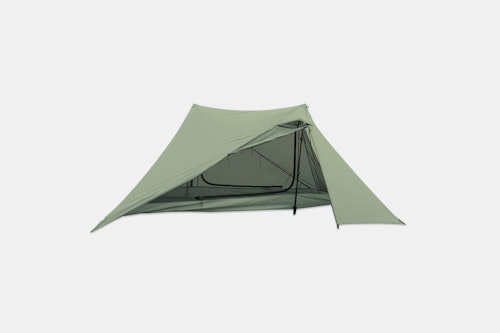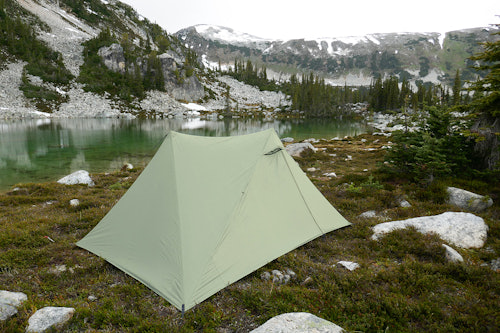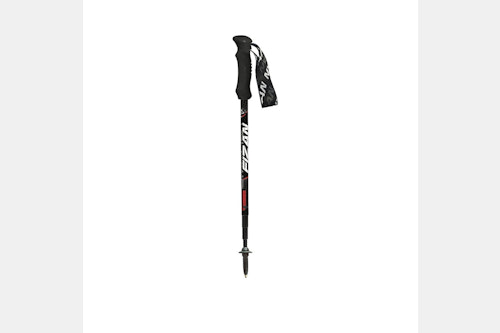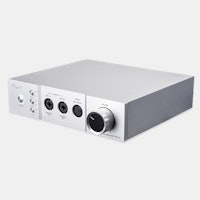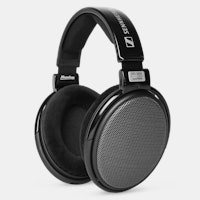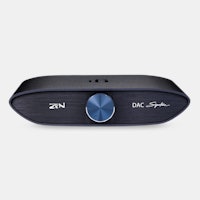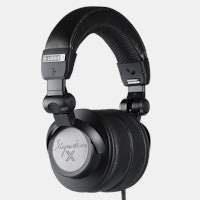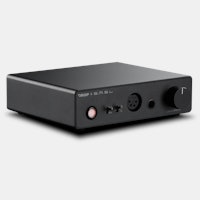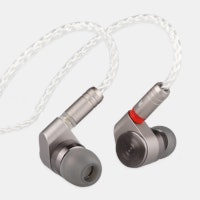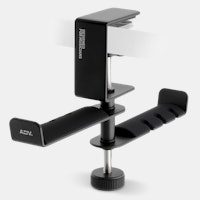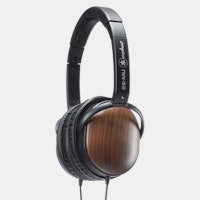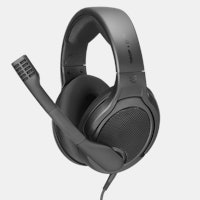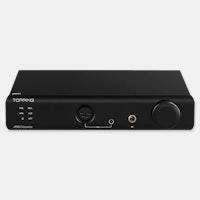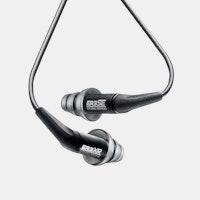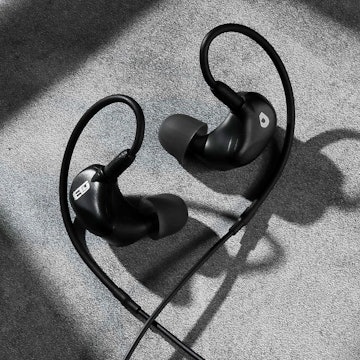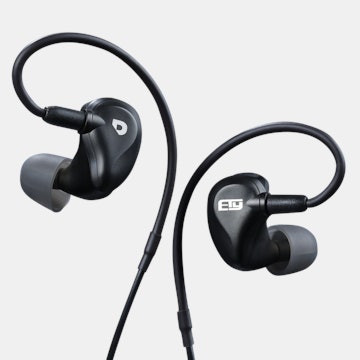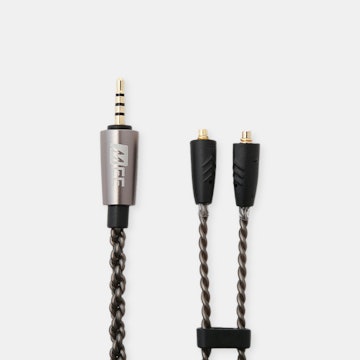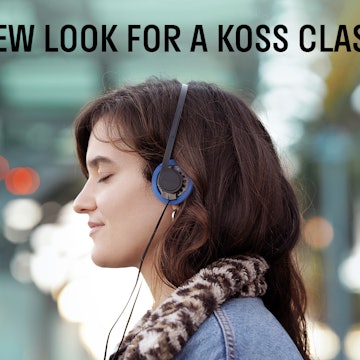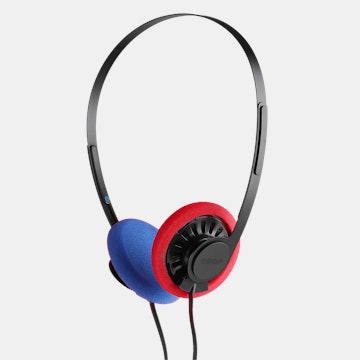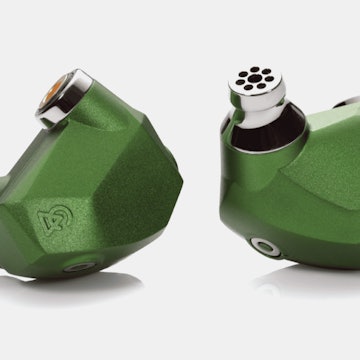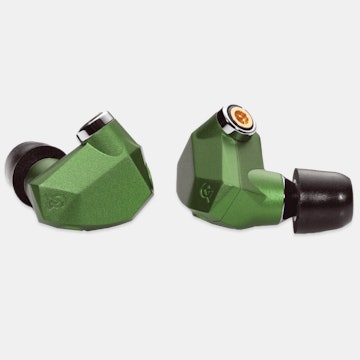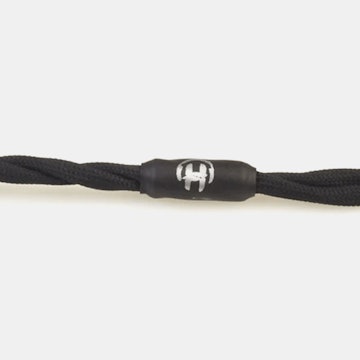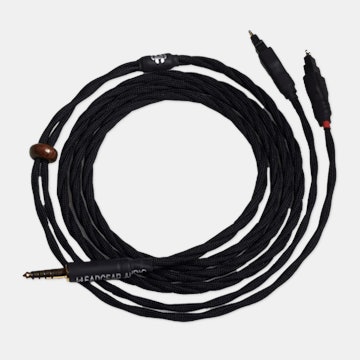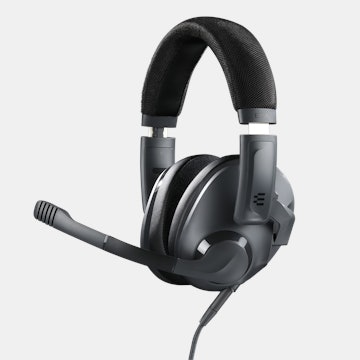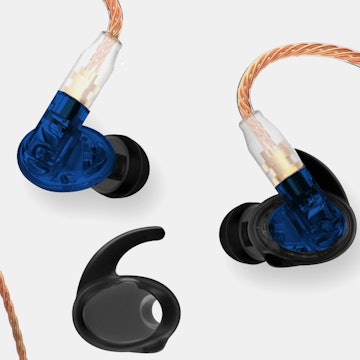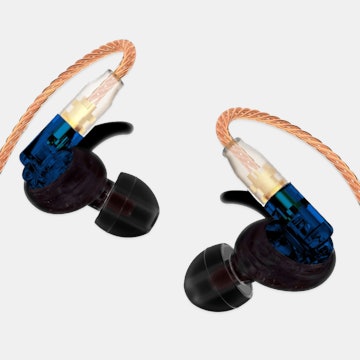Click to view our Accessibility Statement or contact us with accessibility-related questions



























Drop + Dan Durston X-Mid 1P Tent
Drop + Dan Durston X-Mid 1P Tent
bookmark_border
Where's the price?
To negotiate the best possible price for our customers, we agree to hide prices prior to logging in.
4.2K requests
·
Free Returns in USA
Product Description
Designed to be the best double-wall solo shelter supported by trekking poles, the X-Mid is the brainchild of Dan Durston, an experienced thru-hiker and established member of the ultralight community. It aims to solve the common issues seen in trekking-pole-supported tents: Most are single-trekking-pole pyramids, which lack headroom, or overly complex multi-pole designs, which are tedious to pitch Read More

search
close
Sort by: Top Conversations
keyboard_arrow_down
bcyork
19
Jul 6, 2018
Looks like a not as good of version as the Tarptent Stratospire 1 (which I have). It is a well made tent with a variety of guy out and up options and the option of solid or mesh interiors is awesome for all conditions. It holds up well in near gale force winds. To me this is just a straight knock off of Henry Shires strongest tent but missing some important aspects such as panel pull outs and the strut supported 'pitch lock' corners which hive a steeper angel to the wall and help with wind and snow loading. Its frustrating to see this "designer" completely steal a unique tent design sans the patented pitch lock corners. Arrgg. Massdrop please do your research before putting knock off products on here.
TarptentStratospire1instrongwind-YouTube.jpg?auto=format&fm=jpg&fit=max&w=796&h=425&dpr=1&q=70)
TarptentStratospire1instrongwind-YouTube.jpg?auto=format&fm=jpg&fit=max&w=796&h=425&dpr=1&q=70)

dandurston
5116
Dan Durston
Jul 6, 2018
Thanks for checking out the X-Mid. As the designer, I think you'll find it's an awesome tent. The design combines first principles thinking, innovative ideas and extensive thru-hiking experience to create the ideal solo shelter.
The goal with the X-Mid was to start with a clean sheet of paper and reason from there to create the best trekking pole supported solo shelter – one that offers maximal functionality, space, storm resistance and simplicity at the lowest weight. The end result is a design that "just works" when you're tired at the end of a long day and want a tent that pitches without fiddling, or when it's been raining all day and you want a tent that pitches without getting the inside wet, doesn't sag in the rain and gives you ample vestibule space to stow wet gear. The X-Mid sets a new standard for simple, lightweight functionality.
The most fundamental - and thus first - design question was: What shape should form the tents base? Most trekking pole supported tents are based around hexagons or even more complicated shapes, but as the number of sides increases, so does pitching complexity, number of seams, stakes and weight. Typically these complex tents require estimates of stake locations, angles, distances between stakes, pole lengths and pole positions. Setting that up can be fun in the backyard, but not fun in a rainstorm. The X-Mid is rooted in the philosophy that simpler is better, and thus eliminates this guesswork by opting for a rectangle base - by far the easiest shape to stake out.
The challenge with the rectangle - and the reason why it hasn't been used more historically - is that it’s hard to implement a good trekking pole structure. Most prior rectangle based tents have been single pole pyramids (e.g MLD DuoMid), which are lauded for their simplicity, but lack headroom and the single pole near the center typically interferes in the living space or with access. Other rectangle based designs have used two poles to improve living space, but these have either located the two poles centrally where they again interfere in the living space (e.g. Black Diamond Beta Light) or alternatively, located them near the perimeter (e.g. Sierra Designs High Route 1) which creates overly steep (wind catching) walls, adds mandatory guylines and increased stake requirements.
Reasoning from first principles, it was obvious that the ideal solo tent should use two poles to bolster living space since hikers commonly have two poles on hand anyways and it would be a shame not to utilize these resources, but how to achieve this while avoiding the long list of common pit-falls was a design challenge that resonated in my head throughout my 2014 PCT thru-hike. It resonated again during my 2017 Great Divide Trail thru-hike until I realized a solution to all of these long standing issues with the X-Mid layout:
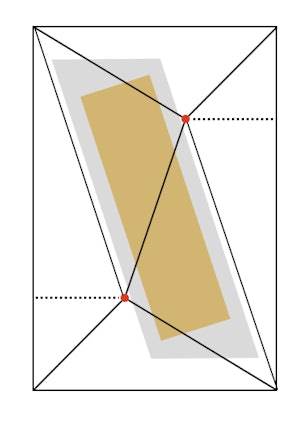
https://youtu.be/cVboRcwY6P0
https://youtu.be/U9vOLs12KQE

https://youtu.be/cVboRcwY6P0
https://youtu.be/U9vOLs12KQE
(Edited)

dandurston
5116
Dan Durston
Sep 7, 2019
Check out this thread for a summary of you could expect. Short answer is that it depends a lot on expectations. You can certainly make it work, but you’ll end up touching the bug mesh sometimes which many don’t think is a big deal but some people don’t like it:
https://drop.com/buy/massdrop-x-dan-durston-x-mid-1p-tent/talk/2502003

TheMailman1
24
Sep 7, 2019
dandurstonOk awesome thanks for the quick reply will continue to do my homework 👌

JaleesaG
1550
Marketing Team
Apr 1, 2019
UPDATE FOR JULY, SEPTEMBER AND DECEMBER 2018 PRE-ORDERS
Hi all,
Great news! We’re excited to announce that the Massdrop x Dan Durston X-Mid 1P Tents have arrived at our warehouse and shipping will begin soon. We now estimate we’ll begin shipping by the end of next week.
If you need to change your delivery address, please contact Community Support through your transactions page (https://www.massdrop.com/transactions) by Thursday, April 4th at 5:00 pm PT.
We look forward to you receiving and enjoying your tents soon!

Crawlas
2
Jun 1, 2019
21% vat +13 euro to the postal service which is normal but also 12% import rights which seems pretty high since you pay only around 4,2% for most products. The item is marked as: tents from different textiles which made it more expensive then i expected. I didn't know tents where in one of the highest brackets. even tablets/phones or watches are cheaper to import.
(Edited)

dandurston
5116
Dan Durston
Jun 1, 2019
CrawlasThanks for the info. The various tariff rules worldwide sure make it tricky to know how things will play out.

StringBender
16
Dec 20, 2018
Checking back in after a break. Any update on DCF and/or 2P X-Mid? I am sure the are hints in this [long] thread, but thought I would bring it to the top for those interested. Waiting to pounce in from the weeds. Thanks Dan.
rel406
30
Jul 2, 2019
Same here! I'm actually going to be out of cell range backpacking in the Pintler's next week. I've got this fear that the 2p will drop just as I head out, and be gone before I get back.
bpchristensen
172
Jul 9, 2019
StringBenderInfo just posted on the 2P
https://drop.com/buy/drop-x-mid-2-person-tent-designed-by-dan-durston/story?
REX1
6
Jul 10, 2018
I really don't understand why you're not using Dyneema Composite Fabric. Maybe you can explain why granite is more money but it's lighter and 100% waterproof and you can also get breathable Dyneema Composite Fabric. Specially the bathtub of the tent and outer walls which makes a tent that does not leak water. I mean I guess I understand you're trying to keep the cost down but most of us are trying to keep the weight down. I really like your design but for what it is it looks a little heavy compared to some of the competition such as the duplex Tent from zpacks granite it's three times the price of your tent but it only weighs 19 oz I would think this would be a target and goal to go after specially since it's a two person tent versus a one. Like I said I like your design I wish it was lighter and I would jump in on the drop. I wish you the best luck with your tent let us know if you make it on a Dyneema Composite Fabric.

dandurston
5116
Dan Durston
Oct 12, 2020
I'm not sure exactly, but I think there is. The good way to do DCF is with hot bonding (rather than room temperature applied tape) because it's a lot stronger and more temperature stable (normal tapes slip a bit in hot temps, and loose a lot of strength in deep cold so they're sketchy for winter use). When you hot bond it, you have to press it for so many seconds every few feet, so I think it ends up quite a bit slower than sewing. Not sure how much slower though.
pngbingo
2
Oct 12, 2020
dandurstonThat makes sense. I really like your approach to tent design and problem solving. I like your idea of a DCF fly, with your other material on the floor. If you ever do a small batch as a trial let me know. I'd also be interested in a 3p version of your current materials or a future DCF version. (I've got kids to fit in :)
TheGoose
4
Mar 24, 2019
24Mar2019. i would like a drop date. i have the itch to go hiking. If i can't at least order this tent i may just pick up a lanshan 2 not sure yet. any suggestions if i can wait for the x-mid?

LoneWolfCanada
19
Mar 29, 2019
How are we supposed to trust Massdrop to deliver on time, when they can’t even open the drop when they say they will??
nothing against u Dan, but this is getting Ridiculous! ...........reopen Friday 2024 maybe

dandurston
5116
Dan Durston
Mar 29, 2019
LoneWolfCanadaIndeed this is painful. In their defense, they did just say it would be today and not a specific time, so it hopefully that it is still accurate and it opens in another hour or so. If not, that is disappointing.
Edit: Drop is now open (mid-morning)
Edit 2: Drop is now sold out (late evening).
(Edited)
michelle_v
32
Aug 1, 2019
I’ve owned the X-Mid 1P for 8 weeks and have since brought it out on 3 trips: the Lost Coast, the High Sierra Trail, and to Emigrant Wilderness. Those who’ve ordered the 1p from the last drop and are waiting on its delivery, or those who have yet to bring it out into the field, may find this helpful. I’ll be addressing:
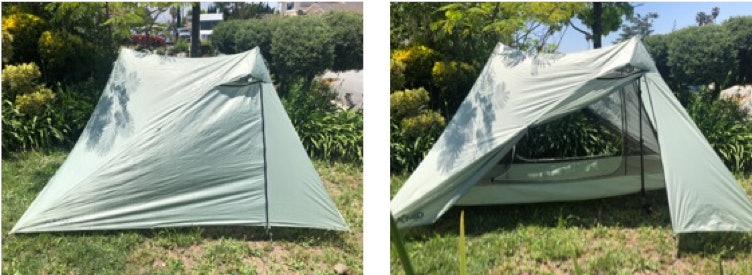

THE X-MID 1P ON THE LOST COAST During the first night's camp setup at Spanish Flat, wind was traveling at 10-12mph with ~20mph gusts for over ~5 hours in the late afternoon. I didn’t use the Tyvek footprint during this night’s setup. While I considered some minor abrasion, I didn’t think the dry sand would damage the bathtub floor. I wanted to test its fragility.


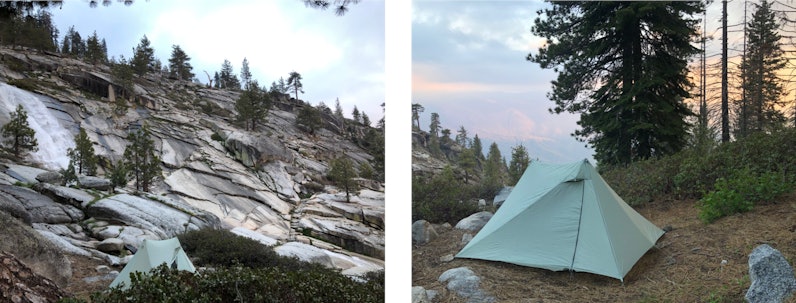

REPAIRS No outdoor gear is made perfect. Much of the reason why we spend time outdoors is to experience elements of nature – some of which we can’t control and in unpredictable, but we prepare to the best of our abilities. With that said, I’m a firm believer in that gear should be tested and trusted to perform, but I expect my things will sustain some type of damage at some point for the abuse it’s unintentionally put through. I knew the tent was structurally sound despite the small tear at the peak – this was proven when I re-tested it at home, then brought it back out through the High Sierra Trail un-repaired. At worst it might get some drops of water running down the interior of the fly in the case of heavy rain. At best, the interior would stay dry in the rain because the tear occurred right above the black reinforcement patch (a PU-coated 210D nylon) which would catch any moisture from dripping inside. My gear and I would be going through some long and difficult trips soon so it was in my best interest to learn how to repair it if something were to happen in the field. You can’t call for a warranty replacement 10,000ft high and 100mi into the Alps. I e-mailed Dan when I returned from the High Sierra Trail to let him know about the small tear, the tiny hole in bathtub floor, and the 2 tiny holes in the mesh wall. The 1P is his first-produced tent design so I wanted to make sure he had feedback for his next iteration. It’s an incredibly well-designed tent in terms of space, ease of pitch, and weight so I want to see the X-Mid line succeed. The holes on the bathtub floor and mesh are easily repaired by tenacious tape and mesh repair patches -- routine for any tent, so the following will address repairs to the peak tear. If you’ve been doing enough research online on this tent via Drop, Reddit, Backpacking Light, etc. you’ll know that Dan is usually quick to respond to any and all comments and questions. No different with my e-mail, which I appreciated. He sent me a detailed e-mail on: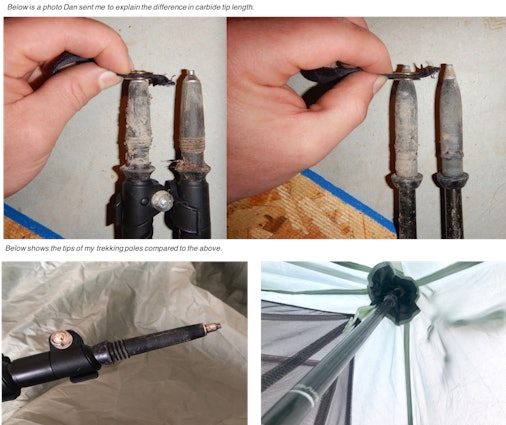
Tenacious Tape This will be used on the interior side of the fly. I happened to already have tape (color: Platinum) that matched the tent color in case you need the tape for other patches and color matching is important to you. The platinum-colored tenacious tape matched more closely to the sage green tent color than the actual sage green tape color which looks too dark. The sack that came with the tent stakes Cut a piece larger than the tear to use as an exterior patch. Silicone To be used as glue and sealant.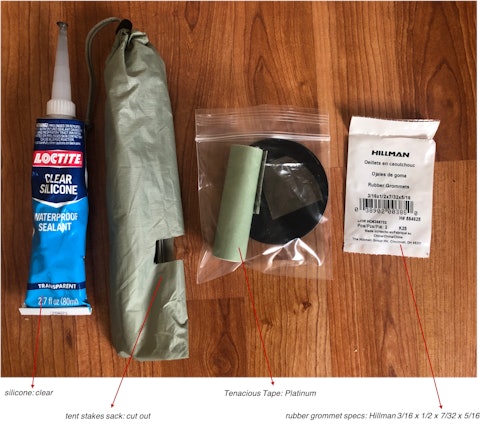
Step 1: Install rubber grommets to both peaks Inserted part of the rubber grommet at an angle from behind the tent grommet, and pushed up/squeezed through via the edges of the rubber grommet. This is easier than placing the rubber grommet on top of the tent grommet and pushing down.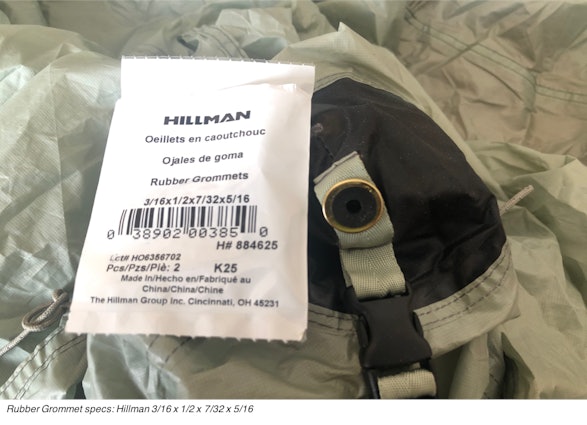
Step 2: Slide Tenacious Tape under the tear for the initial patch This step was the most difficult, relatively-speaking. The tear was so small that it was a little difficult sliding the tape underneath. I couldn’t simply flip the tent fly over and tape it from the interior side of the fly because the tear occurred right above the black reinforcement patch which was still in tact and blocking access to the tear (actually a good thing). Placing tenacious tape underneath served as the “first patch” to close the tear. Step 3: Use the silicone as glue and apply it to the exterior side of fly to seal the tear Once the silicone is applied to the tear, I placed the cut material from my tent stakes sack over it, pressed down gently, and flattened.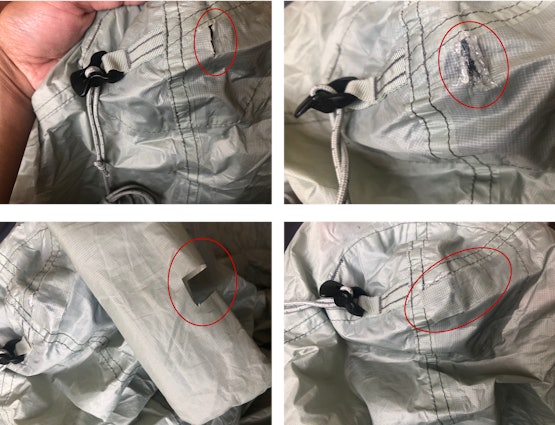
Step 4: Apply silicone to the edges of the patch I applied another thin layer of silicone to the edge of the patch to make sure it completely sealed to the tent fly. Scraped any extra silicone off for a cleaner look. Step 5: Let the silicone dry I let my tent sit out for 24 hours to make sure the silicone dried before placing it back in its stuff sack. The X-Mid 1P in the Emigrant Wilderness I took the tent back out the following weekend for a short test trip to the Emigrant Wilderness. During setup I could already feel the difference the rubber grommets made in relieving stress to the peaks. Now it didn’t feel like the carbide tips would tear through. The patch to the tear upheld through the night.
VERDICT At 27.9 oz for the fly with guylines + mesh inner; all of the X-Mid’s features; and the ample interior and vestibule space, the X-Mid is almost the perfect 1P non-freestanding tent. For those who are just now receiving the 1P, I would make a few suggestions and set the following expectations -- some of these are applicable to all tents, not only the X-Mid:
- First Test Pitch & First Impression
- Performance on the Lost Coast: Minor Damage Sustained
- Performance on the High Sierra Trail: Unrepaired
- Repairs: How-To
- Performance in the Emigrant Wilderness: Repaired
- 2-door, 2 vestibules
- Double-walled with ability to pitch fly first and/or pitch inner only
- Sub-2 lb. min weight preferred
- Freestanding/semi 2P preferred, 1P non-freestanding considered

- Stress on the rain fly/vestibule zippers if too taut > won’t fully close, leaving ~1” unzipped
- Carbide tips from trekking poles can weaken, puncture, or tear the peaks > visible imprint of the trekking pole tips at the peaks
- Very simple pitch
- Seam-sealed
- 2 large vents
- 2 long mesh pockets
- Buckles for inner height adjustment and bathtub lift
- Fly comes low to the ground
- Packs small

THE X-MID 1P ON THE LOST COAST During the first night's camp setup at Spanish Flat, wind was traveling at 10-12mph with ~20mph gusts for over ~5 hours in the late afternoon. I didn’t use the Tyvek footprint during this night’s setup. While I considered some minor abrasion, I didn’t think the dry sand would damage the bathtub floor. I wanted to test its fragility.




- I’m not sure if this is applicable to all other tents since it is not for the REI QD 2P, but the zippers on the X-Mid can easily be opened and closed with one hand. It doesn’t seem like a big deal until your hands are full and you’re trying to quickly open and close the fly and inner to keep swarming bugs out.
- The line at one of the corners (R - photo below) is already starting to fray. I always make sure to relieve some tension by gently tugging the tent and holding on to the webbing to create some space before pulling it to tighten the pitch, so it’s a little disconcerting to see it already frayed. However, I understand the weight savings of using this particular cord, and I carry extra cord with me anyway in case I need to tie out extra guyline to accommodate for weather conditions.

REPAIRS No outdoor gear is made perfect. Much of the reason why we spend time outdoors is to experience elements of nature – some of which we can’t control and in unpredictable, but we prepare to the best of our abilities. With that said, I’m a firm believer in that gear should be tested and trusted to perform, but I expect my things will sustain some type of damage at some point for the abuse it’s unintentionally put through. I knew the tent was structurally sound despite the small tear at the peak – this was proven when I re-tested it at home, then brought it back out through the High Sierra Trail un-repaired. At worst it might get some drops of water running down the interior of the fly in the case of heavy rain. At best, the interior would stay dry in the rain because the tear occurred right above the black reinforcement patch (a PU-coated 210D nylon) which would catch any moisture from dripping inside. My gear and I would be going through some long and difficult trips soon so it was in my best interest to learn how to repair it if something were to happen in the field. You can’t call for a warranty replacement 10,000ft high and 100mi into the Alps. I e-mailed Dan when I returned from the High Sierra Trail to let him know about the small tear, the tiny hole in bathtub floor, and the 2 tiny holes in the mesh wall. The 1P is his first-produced tent design so I wanted to make sure he had feedback for his next iteration. It’s an incredibly well-designed tent in terms of space, ease of pitch, and weight so I want to see the X-Mid line succeed. The holes on the bathtub floor and mesh are easily repaired by tenacious tape and mesh repair patches -- routine for any tent, so the following will address repairs to the peak tear. If you’ve been doing enough research online on this tent via Drop, Reddit, Backpacking Light, etc. you’ll know that Dan is usually quick to respond to any and all comments and questions. No different with my e-mail, which I appreciated. He sent me a detailed e-mail on:
- What may have caused the tear,
- Suggestions on how to fix the tear, and
- A recommendation on how to further reinforce the peak to prevent another tear

- 1/2” O.D., 7/32” thickness, 5/16” groove diameter, 3/16” I.D.
Tenacious Tape This will be used on the interior side of the fly. I happened to already have tape (color: Platinum) that matched the tent color in case you need the tape for other patches and color matching is important to you. The platinum-colored tenacious tape matched more closely to the sage green tent color than the actual sage green tape color which looks too dark. The sack that came with the tent stakes Cut a piece larger than the tear to use as an exterior patch. Silicone To be used as glue and sealant.

Step 1: Install rubber grommets to both peaks Inserted part of the rubber grommet at an angle from behind the tent grommet, and pushed up/squeezed through via the edges of the rubber grommet. This is easier than placing the rubber grommet on top of the tent grommet and pushing down.

Step 2: Slide Tenacious Tape under the tear for the initial patch This step was the most difficult, relatively-speaking. The tear was so small that it was a little difficult sliding the tape underneath. I couldn’t simply flip the tent fly over and tape it from the interior side of the fly because the tear occurred right above the black reinforcement patch which was still in tact and blocking access to the tear (actually a good thing). Placing tenacious tape underneath served as the “first patch” to close the tear. Step 3: Use the silicone as glue and apply it to the exterior side of fly to seal the tear Once the silicone is applied to the tear, I placed the cut material from my tent stakes sack over it, pressed down gently, and flattened.

Step 4: Apply silicone to the edges of the patch I applied another thin layer of silicone to the edge of the patch to make sure it completely sealed to the tent fly. Scraped any extra silicone off for a cleaner look. Step 5: Let the silicone dry I let my tent sit out for 24 hours to make sure the silicone dried before placing it back in its stuff sack. The X-Mid 1P in the Emigrant Wilderness I took the tent back out the following weekend for a short test trip to the Emigrant Wilderness. During setup I could already feel the difference the rubber grommets made in relieving stress to the peaks. Now it didn’t feel like the carbide tips would tear through. The patch to the tear upheld through the night.

VERDICT At 27.9 oz for the fly with guylines + mesh inner; all of the X-Mid’s features; and the ample interior and vestibule space, the X-Mid is almost the perfect 1P non-freestanding tent. For those who are just now receiving the 1P, I would make a few suggestions and set the following expectations -- some of these are applicable to all tents, not only the X-Mid:
- No matter what poles you use, add the rubber grommets to the already-existing grommets at the peaks for an extra layer to protect the tent from the poles’ carbide tips.
- If the tent can’t be pitched perfectly at a 90* angle, even if taut on all sides, expect slight sagging at the ridgeline – it may be noticeable from the outside but seems insignificant once you’re inside the tent.
- Reminder that this doesn’t come with a footprint so create one with Tyvek or polycro.
- I would recommend this for any tent, even if not the X-Mid, whether or not it comes with a footprint or is a separate purchase – Tyvek and polycro are usually cheaper and lighter than any brand’s footprint anyway.
- It’s easier to pitch the tent if all the zippers are closed.
- Roll/fold the tent to protect the mesh before stuffing back into its sack or in backpack to minimize mesh stretches and holes.
- If you experience holes in the mesh caused by stretch/misalignment and not by an actual tear, scratch at it with your nails semi-vigorously – the mesh should straighten back to its original form.

dandurston
5116
Dan Durston
Jun 30, 2020
Do you have an X-Mid from 2019? The first couple batches had the higher grommet position where some tips could pose an issue like this, but I think we've got it solved now, so if this is a 2020 tent it would be good to hear more about what happened (e.g. what poles you have).
(Edited)
martha_w
2
Jul 1, 2020
dandurstonOne day I hope to be able to cross the border into the U.S. and pick up the 2p X-Mid I ordered last fall and had shipped to a Michigan address, but I may be taking it out for an inaugural winter camp at this rate! Regardless, it sounds like the lowered grommet position will be more compatible with the CMT poles I use.
Those CMT poles are the same ones Ive used on past trips with my 2019 iteration X-Mid, including the recent one on which I had the tear. Additionally I had just raised my pole height a bit to reduce some ridge line sagging when I got the tear. No mystery really.
I appreciate your commitment to the X-Mid and its users.

TheSmizzle
2
May 4, 2019
Interesting how the last drop about a month ago had supposedly 300 available and it was sold out in 24 hours, with over 4,000 on the request list before this drop I would think that it would already be sold out again. This drop must be way over the 300 available on the last one because it's been 4 days and pre-orders are still open. Does anyone have any insight on how many are available or if this is a whole new order? I'm planning on using this tent on my thru-hike of the AT in April of 2020, hope it gets here before than 🤣

JayIOM
17
May 27, 2019
Another for the part solid inner, for the 2 person tent when its available. It gets windy and cold up on them hills.
Hopefully a mesh inner would also be available for summer glen camping for a reasonable additional price?
Also a lot of folk have been adding a small inner buckle to the bottom of the fly zip, in part to take the tension off the zip, but it also allows additional venting for the tent without having the doors flapping around.

djbraide
6
Oct 29, 2020
JayIOMI have not seen these tents in the flesh but the design, and general quality make them highly desirable but two things hold me back, I too would like a solid inner for UK conditions and also the fly to be in a darker, less conspicuous colour. Most UK customers would choose these options if available and I would be happy to pay more for them.

dandurston
5116
Dan Durston
Dec 4, 2018
BislyHi Bisly,
Sorry I've been slow to answer this one. Tent comparison questions are my favorite, so I wanted to take my time and do a good job. I should also mention I've never used or seen a Lunar Solo (I have looked over a Lunar Duo) so it's possible that something I say is wrong, but I am trying to be fair.
First, the X-Mid and the Lunar Solo are comparable in many ways. They are both trekking pole supported 1P tents and they even both use 20D silpolyester for the fly fabric, which is great because it doesn't sag/droop in the rain like nylon. However, they do have one fundamentally large difference, which is that the Lunar Solo is a single wall design whereas the X-Mid is a double wall. Single wall tents are lighter since there's just one layer of material but they give away a lot of functionality to save that weight. They don't provide protection from contacting condensation and they aren't modular, so they aren't nearly as nice in sloppy conditions and you can't use just the inner tent or just the fly as conditions warrant. Basically single wall tents are a more specialized design that is better suited to moderate conditions, whereas double walls are more well rounded for a wider range of conditions. A double wall is better in hot conditions (use just the inner), rainy conditions (protection from condensation), cold conditions (a bit warmer) and outside of bug season (go even lighter with fly + groundsheet).
Anyways, here are properly scaled diagrams of these two tents:
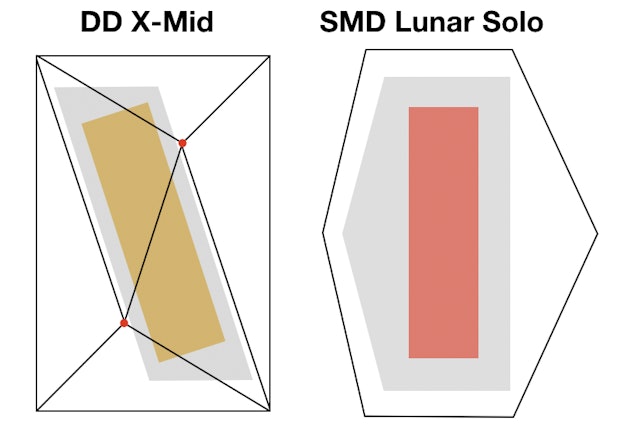
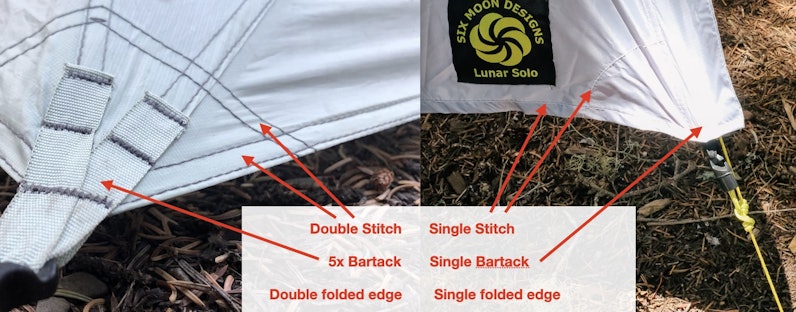


- Superior peak ventilation from dual vents (vs one)
- The X-Mid vents can rapidly shut and seal via velcro in harsh weather. The Lunar Solo vents appear to be non-adjustable.
- The X-Mid fly extends right down to the ground (depending on the pitch) so you can stop rain splatter, drafts, blowing snow and sand, whereas the Lunar Solo fly has an unavoidably large gap around the bottom. The large gap of the LS saves weight but gives up protection. You can raise the X-Mid up a few inches if you want more bottom ventilation.
- The X-Mid uses higher end hardware. For example, it uses high end YKK water resistant zippers rather than basic zippers covered with a velcro flap which doesn't work as well and are prone to snagging. If you read the reviews on SMDs site you'll see this is a complaint.
- The X-Mid fly can be used as a light/minimal two person shelter without the inner
- The X-Mid has two doors versus one.
- The X-Mid has dual vestibules versus one (24 vs 6.5 sq ft).
- The X-Mid uses tough #5 zippers (I'm not sure but I expect the Lunar Solo uses #3 zippers which wear out much sooner).
- The steeper walls of the X-Mid will shed snow better
- Since the roof panels of the Lunar Solo are fairly low angle, heavy condensation may drip onto the sleeper, where the X-Mid has steeper roof panels so even heavy condensation would run down the fabric instead of dripping.
(Edited)
Xymnslot
380
Dec 4, 2018
dandurstonI just have to say that I am neither a tent aficionado nor an experienced outdoorsman, but I LOVE reading your discussions on the X-Mid because of your thoughtful, informative, and thorough responses. Listening to experts talk about the things they love is one of my favourite things and somehow, I randomly stumbled on your posts on Massdrop doing exactly that. Kudos and good luck with your product - if I find myself in need of a lightweight tent, this will be the one I go for on the strength of your posts alone.

Lherm
6
Jul 24, 2018
1. Besides the pole tie outs in extreme weather, any other tie outs?
2. Can the tent be pitched higher for more ventilation without stretching the mesh inner?
3. Does the 20D SilPoly have any ripstop in it?
4. So far 131 tents have been sold with one week left. What was your/Mass Drop goal? Good enough results for 2nd run?
2. Can the tent be pitched higher for more ventilation without stretching the mesh inner?
3. Does the 20D SilPoly have any ripstop in it?
4. So far 131 tents have been sold with one week left. What was your/Mass Drop goal? Good enough results for 2nd run?

StringBender
16
Aug 27, 2018
I have run across 2 threads recently encouraging both HL and ZP to look at and reference your design and consider making a 1P and 2P DCF version. I am sure you are probably aware of more. Clearly, you have a lot of people's attention. I guess that is good news/bad news. I am hoping that you will be the price leader if not first to market. There is that economy of scale and experience with DCF thing that might be a problem. Maybe you can work with one or the other and work out a signature model(s). Just thinking out loud……….

dandurston
5116
Dan Durston
Aug 27, 2018
StringBenderWho's HL? I'd be interested to see any X-Mid related threads that I haven't noticed.
I am working on the DCF version - I had a 1P silpoly prototype set up last night mulling over various options for how it could turned into a single wall. Most of the 1P DCF design is figured out, so I'm optmistic that we can get a prototype started in the near future. I expect other companies wouldn't be that interested in coming out with a X-Mid "inspired" DCF tent because anything from them would likely be more expensive and slower to market than one from me.
In terms of experience with DCF, I've been working with DCF/cuben for over 10 years on a personal level including MYOG tents, tarps, rain jackets, stuff sacks, packs etc. So I'm comfortable managing how the seams, bias and reinforcements are designed. Thus as long as we have a manufacturer who can follow instructions well and has good QAQC proceedures, we should be able to produce a quality product. But of course it would be ideal to work with a manufacturer with as much experience as possible so less oversight is needed.
In terms of value, I think this collaboration with Massdrop is well positioned there. The regular X-Mid priced at $199 but it's equivalent to tents priced at $300 -$400. The X-Mid 1P silpoly has higher end hardware (e.g. uretek zippers) and materials than most tents in the $300 price range and also higher construction quality. The reason it's lower cost is because it's produced in scale, yet doesn't have a large retail markup like most other products produced at scale. Most other products are either produced in house with low scale / low automation manufacturing (e.g. Zpacks, YMG) or outsourced but with a larger mark up applied (e.g. MSR, Big Agnes).
With that said, my focus isn't to compete on price. I don't want to attract buyers by offering average tents at a low price. I'd much rather make great tents and then sell them for a fair price. So longer term if I do ever branch out on my own, I expect the tents would be priced similarly to what's out there, and hopefully folks would agree they offer superior functionality and performance.
With regards to partnering with other companies, I think this would be cool but hard to do practically. I think many small ultralight companies make the mistake of manufacturering in house when they don't have the expertise to do a great job of it. Certainly some small in house manufacturers do an outstanding job (e.g. HMG, Locus Gear, Hanchor) but there is also a lot of not well sewn cottage gear. So there are only a few cottage manufacturers that I would be interesting in partnering with, and even then it would be tricky to do practically since you'd have more parties expecting a profit and wanting control over the project. Other smaller companies outsource manufacturing (e.g. TT, SMD, Katabatic etc.) but partnering with these companies would be less efficient than just working with a manufacturer directly. So overall I think the setup with Massdrop is working very well and is providing a high quality product at an attractive price.
Overall, I'm well aware of the substantial interest in DCF versions and I would very much like to do this. I am actively refining the design for a 1P single wall DCF version, and optimistic that a 2P DCF will follow in reasonable amount of time. So hopefully I can get you a 2P DCF X-Mid before too long.
I am working on the DCF version - I had a 1P silpoly prototype set up last night mulling over various options for how it could turned into a single wall. Most of the 1P DCF design is figured out, so I'm optmistic that we can get a prototype started in the near future. I expect other companies wouldn't be that interested in coming out with a X-Mid "inspired" DCF tent because anything from them would likely be more expensive and slower to market than one from me.
In terms of experience with DCF, I've been working with DCF/cuben for over 10 years on a personal level including MYOG tents, tarps, rain jackets, stuff sacks, packs etc. So I'm comfortable managing how the seams, bias and reinforcements are designed. Thus as long as we have a manufacturer who can follow instructions well and has good QAQC proceedures, we should be able to produce a quality product. But of course it would be ideal to work with a manufacturer with as much experience as possible so less oversight is needed.
In terms of value, I think this collaboration with Massdrop is well positioned there. The regular X-Mid priced at $199 but it's equivalent to tents priced at $300 -$400. The X-Mid 1P silpoly has higher end hardware (e.g. uretek zippers) and materials than most tents in the $300 price range and also higher construction quality. The reason it's lower cost is because it's produced in scale, yet doesn't have a large retail markup like most other products produced at scale. Most other products are either produced in house with low scale / low automation manufacturing (e.g. Zpacks, YMG) or outsourced but with a larger mark up applied (e.g. MSR, Big Agnes).
With that said, my focus isn't to compete on price. I don't want to attract buyers by offering average tents at a low price. I'd much rather make great tents and then sell them for a fair price. So longer term if I do ever branch out on my own, I expect the tents would be priced similarly to what's out there, and hopefully folks would agree they offer superior functionality and performance.
With regards to partnering with other companies, I think this would be cool but hard to do practically. I think many small ultralight companies make the mistake of manufacturering in house when they don't have the expertise to do a great job of it. Certainly some small in house manufacturers do an outstanding job (e.g. HMG, Locus Gear, Hanchor) but there is also a lot of not well sewn cottage gear. So there are only a few cottage manufacturers that I would be interesting in partnering with, and even then it would be tricky to do practically since you'd have more parties expecting a profit and wanting control over the project. Other smaller companies outsource manufacturing (e.g. TT, SMD, Katabatic etc.) but partnering with these companies would be less efficient than just working with a manufacturer directly. So overall I think the setup with Massdrop is working very well and is providing a high quality product at an attractive price.
Overall, I'm well aware of the substantial interest in DCF versions and I would very much like to do this. I am actively refining the design for a 1P single wall DCF version, and optimistic that a 2P DCF will follow in reasonable amount of time. So hopefully I can get you a 2P DCF X-Mid before too long.
Showing 341 of 1207
Recent Activity
